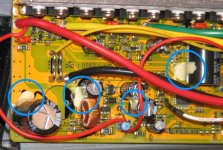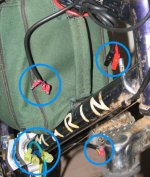Sorry about the long wait; there are just too many things going on lately.

Can't even finish my own stuff (but that is not new).
The fourth wire in the throttle connector is only used for it's battery meter. If it worked before, that's not the problem.
But you can use it to help troulbeshoot, if it is made for the voltage of battery you are using. I would wire up a temporary wire, at least, from that meter wire to the controller positive power wire. Then you will know if you are getting voltage to the controller or not, *and* you can use it to watch for battery sag or cutout, both while testing and later on the road.
If youc an't use that meter for some reason, then use your multimeter set to V, with the red lead into the *back* of the controller's main positive power connector to the battery, and the black lead into the controllers' main negatie power connector to the battery. Do this on the controller side of the connector, to be sure it's reaching the controller.
To be doubly sure, you could take two safety pins, and push the pin thru the insulation of your controller's battery power wires, ensuring you don't short the safety pins to each other or anything else. Then touch the safety pins with your multimeter leads. That tests what you get at the *wires*, whcih is a better test than what you get at the connector pins. Again, it has to be on the controller side of the connectors.
If you get normal battery voltage, then turn on the bike/controller, if it isn't already, and see if it stays that way.
If you get no battery voltae or a lower voltage than you get at the battery end, you have a connector problem, or a wire broken inside the insulation.
To test current draw:
The main power pins I'm referring to in previous posts are the ones from battery to controller. To test the current draw during the phase/hall tests, without a CA or other wattmeter, you need to insert your multimeter, in 10A mode (if it has one, if not, post what it does have to see if this can be done with it at all), between the positive of the battery wire and the postiive of the controller wire.
I assume that if you dont' have andersons, you are using the same automotive spade style connectors that are on your phases for your battery wires. If so, simply leave the negatives plugge din normaly, and disconnect only the postives.
Put the black meter lead from meter common jack to the battery positive.
Put the red meter lead from meter 10A jack (it is usually separate from the regular V/ohms jack) to the controller positive.
Make sure both are connected well; this may be difficult because you're not going to be able to hold them by hand while you do the rest of this test. If you have spare banana plugs, and spare spade lugs and some spare wire, you can make test leads specifically for this, to use in place of your meter leads. But you won't need those very often (hopefully only this time), so they might not be worth making.
Make sure the meter is set to it's 10A mode.
Set up the bike so it's motor wheel is off the ground.
Power on the bike, if it isnt' already.
The multimeter should register some current, maybe 0.1A or less. If there is no current registered at all, it's possible there is a connection problem with the meter leads to the power leads at controller or battery, or that the problem is within the bike stuff.
Very slowly move the throttle up from zero to just enough the motor would normally begin spinning, watching the multimeter the whole time. It should register more current, up to a couple of A or more, if the wheel were moving, or even if the phase coils are getting current flow from the controller but not moving.
If nothing at all happens, no current, again it could be the meter connections, or the controller could be dead, or a connection in the bike harness, etc. If the current reading is very high even at tiny throttles, something else is wrong (possibly the phase or hall order).
You can test the halls individually, too, to see if they are getting power from the controller, and that they are outputting the right signals, either with your meter or with a DIY tester. There are at least a couple of those described and shown in threads on ES, so youc an build one if you want. It's easy enough, or you can buy one from Lyen (which will test other things on teh bike, too).
Same thing with the throttle--you can test it to see if it is actually even doing anything when you move it. Reember that it won't output 5V, but rather just a small range of voltage somewhere between 0V and 5V; though you should get 0V on the ground wire and 5V on the postive wire.
It is still very possible that your original combination that appeared to work was too high a current draw, and damaged something in either controller or motor from the resultant heat.



